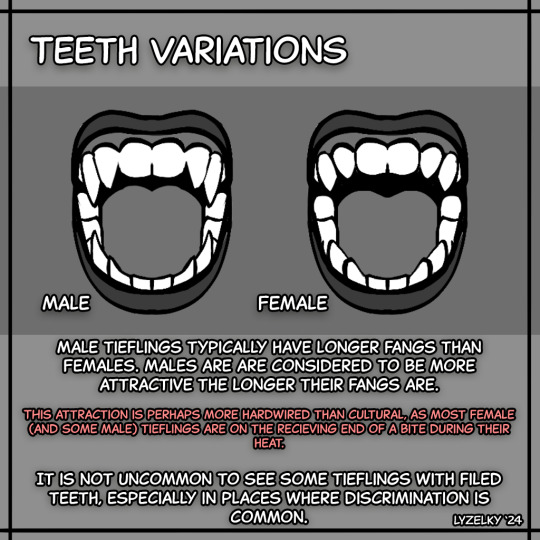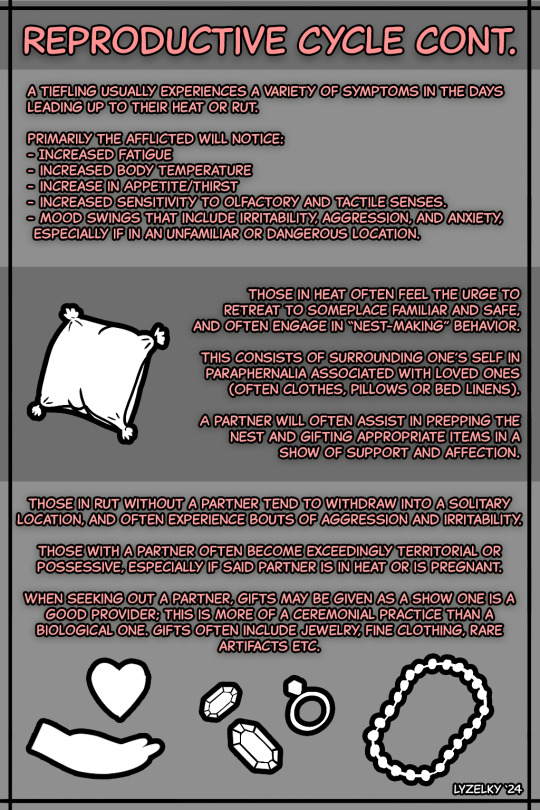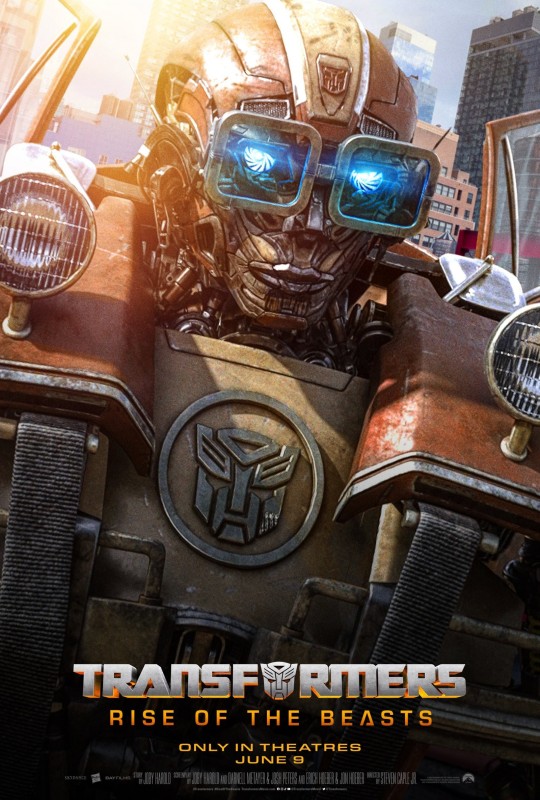#cat gestation is 2 months
Explore tagged Tumblr posts
Text
yellowfang was pregnant with brokenstar for about 10 months if you want to know why he was so fucked up
#warrior cats#cat gestation is 2 months#yellowfang and snowfur became pregnant around the same time in early 1998#whitestorm was born in summer (as was scourge probably)#but brokenstar wasn’t born until 6 months after that#This is based off of my research + multiple canon timelines#obviously it’s not exact.
35 notes
·
View notes
Text
I recently received a request for my tiefling headcanons, (also mentioned in this comic) so I put together a ramshackle biology guide for them. It's not 100% faithful to DnD or BG3 lore, but I borrowed enough from them that it's pretty interchangeable.
IMPORTANT: I tried to keep most things as clinical as possible to avoid Tumblr-geddon, but anything vaguely NSFW in the comic has is written in pink text for your convenience.
((CW: Clinical (Non-Graphic) descriptions of Heat/Rut cycles, menstruation, no A/B/O)) I'm also going to copy over all the text from the panels into text format on here so y'all can just read them if you want.







Text version below!
INFERNAL TRAITS
Tieflings possess a variety of features that hearken back to the Hellish influence in their bloodline. Often these traits are animalistic in nature, though in extreme cases may appear more akin to aberrations.
Common features include glowing eyes, horns, clawed fingers and toes, and tails.
Tieflings are inclined to be left handed or ambidextrous.
Less common traits include hooves, paws, or talons for feet, wing like appendages, goat-like ears, a forked tongue, etc.
A Protruding Brow ridge and cheekbones are more common among males. They are considered attractive by some and less so by others, and it seems to crop up in those who are closer to their Infernal sire (I.e, the direct child of a cambion).
Tieflings possess raised ridges on various parts of their body. They can range from boney and firm to soft and fleshy, with the intensity and abundance of ridges varying per individual.
EYE VARIATIONS
The eyes of a tiefling born to two tieflings will almost always have infernal coloring. In this regard, the scelera should be jet black and glossy, and the iris vibrant and produce a strong glow.
The eyes of a tiefling born to humans can either have infernal or mundane coloration. The pupil is usually oblong, but other shapes have been known to occur.
A child born to one tiefling and one human has an equal chance of inheriting either trait.
In both cases, the pupil functions like a cat’s would; narrowing in bright light, and dilating in darkness or while in a state of heightened emotion.
TEETH VARIATIONS
Male tieflings typically have longer fangs than Females. Males are are considered to be more attractive the longer their fangs are.
This attraction is perhaps more hardwired than cultural, as most female (and some male) tieflings are on the receiving end of a bite during their heat.
It is not uncommon to see some tieflings with filed teeth, especially in places where discrimination is common.
TAIL VARIATIONS
The shape of The tail tip (Often referred to as a ‘spade’) manifests in a variety of forms, with some sporting tufts of hair or even fins.
Tiefling Parents might take their newborn to a fortune teller to predict their child’s lifeline based on the spade and other distinctive features. (Longer tail = Longer life, Thin Tail = Weak Constitution, etc.)
Long tails are typically seen as more attractive, but it’s usually down to a matter of preference.
Although their tails are not prehensile, having a dexterous tail is often seen as a sign that someone is more skilled in bed.
REPRODUCTIVE CYCLE
Like humans, tieflings endure a 9-month gestation period, and all other developmental markers remain the same despite most tieflings living upwards of 200 years.
Tieflings differ slightly in regards to ovulation and fertility. Unlike humans, tieflings will experience either a heat or a rut that is the primary driver of their breeding cycle.
Females typically experience their first heat at around 16-18, with males experiencing their first rut at around 18-20.
Unlike a human menstruation cycle, females will go into heat every 2-3 months for 1-2 days at a time, after which menstruation will last for about 4 days.
A rut occurs at roughly the same frequency, but can be triggered early by heat pheromones.
Many tieflings use potions, herbs, or magic items to mitigate their heat/rut cycle, but long term usage is not advised.
During this period, the afflicted experiences heightened arousal and an instinctual urge to breed. Fertility is increased during this period.
Increased production of pheromones signals potential mates that one has entered heat/rut.
Scent glands along the hips, jawline, tail and neck become highly sensitive.
“Tail flagging” may occur, in which the tail lifts and inches over to the side to provide “easier access”.
Heat and Rut Symptoms
A tiefling usually experiences a variety of symptoms in the days leading up to their heat or rut. Primarily the afflicted will notice:
- Increased Fatigue
- Increased body temperature
- Increase in appetite/thirst
- Increased sensitivity to olfactory and tactile senses.
- Mood swings that include irritability, aggression, and anxiety, especially if in an unfamiliar or dangerous location.
Those in heat often feel the urge to retreat to someplace familiar and safe, and often engage in “nest-making” behavior.
This consists of surrounding one’s self in paraphernalia associated with loved ones (Often clothes, pillows or bed linens). A partner will often assist in prepping the nest and gifting appropriate items in a show of support and affection.
Those in rut without a partner tend to withdraw into a solitary location, and often experience bouts of aggression and irritability.
Those with a partner often become exceedingly territorial or possessive, especially if said partner is in heat or is pregnant.
When seeking out a partner, gifts may be given as a show one is a good provider; this is more of a ceremonial practice than a biological one. Gifts often include jewelry, fine clothing, rare artifacts etc.
That's all for now! Let me know if you liked it or not or want more. Feel free to use this stuff for your own stories/fanfics/art whatever, but I'd appreciate if you linked back to this post or my blog if you do. Thanks!
#bg3#tav#bg3 fanart#bg3 tav#bg3 fanfiction#my art#oc art#tiefling#dnd#baldur's gate 3#headcanon#tiefling headcanons#medical#fantasy biology#fantasy#writing#lore#worldbuilding#fantasy worldbuilding#fantasy writing
75 notes
·
View notes
Text
A debate I had on Reddit about abortion rights.
The person I'm arguing with is an active participant of the Mensa subreddit, so they already fancy themselves a genius to some extent.
Me:
No arms, no legs, no heart, no brain. Just a blood vessel pumping blood from the host to the clump of cells.
And the "But there's a heartbeat" excuse is a lie. You're only hearing the host's blood pumping into cells cause the heart isn't fully formed until 10 weeks. Additionally, the brain isn't even fully developed until 24 weeks. No heart organ, no brain, it's not a viable life outside its host body.
Them:
Yeah that's an empirical argument to deny ontology. That's not convincing to anyone who thinks there is an essence to being human that isn't tied to having arms and legs.
Me:
I'm sorry, but are you trying to use philosophy to argue whether or not someone is capable of living without a heart, brain, and lungs?
Them:
How do you determine what is human and what is not? Arms and legs? What do you call someone without arms and legs? Or a mechanic heart? You can't answer the question 'what is human' based on physical qualities only. So yes, logically you cannot answer the question without philosophy.
Me:
I think you are confusing personhood with the human species.
A person is someone who can think, breathe, and exist on their own. They have a personality and their own opinions on subjects like abortion.
A human being or homo sapiens is a species on earth that evolved enough to form social groups and cultures and, therefore, are capable of personhood. Some other more complex animals might be capable of personhood, like Koko the Gorilla. She was intelligent, learned to communicate using sign language, and even had her own pet.
I'm not discussing this subject in terms of personhood. A fetus isn't developed enough to form a sense of personhood if it can't even survive on its own at 2 months gestation.
Them:
I'm talking about the essence of what makes one a living human. As long as pregnant women before the 3rd month believe they're carrying a child, which is all of them who want to *keep* the child, I am not appealed by the argument that it's suddenly no longer a child but rather a fetus for biological/scientific/empirical reasons when there are various financial and social advantages of it being so.
The points you mention are even still different from mine.
Me:
>The points you mention are even still different from mine.
Correct because again, you fail to see the point of the argument.
You yourself say;
>As long as pregnant women before the 3rd month believe they're carrying a child, which is all of them who want to *keep* the child,
That's all fine and dandy cause it's her *choice* to do so, not yours and not the government's. But it's not yours or anyone else's place to force your philosophical or religious views on an entire nation and bully us all into following them by making your opinions a law.
Them:
It's a choice to recognise a human as a human, you're saying? So where's the end to that travesty of logic? A cat is a dog, a man is a woman, that dog is a man and that man is a dog. That's a wild world you're living in. I don't see the world that way, it defeats both logic and common sense. But it surely makes a way to justify doing whatever the hell you like doing. I won't force morality on you, but I'll tell you when it's absent.
Me:
Again, you're trying to use philosophy to argue science, and that gets us nowhere. I already stated I'm not talking from a philosophical standpoint.
You can see the world however you want. Your morals aren't always going to line up with your neighbors morals. Your neighbor might think it's immoral to eat any kind of meat. Are you gonna give up that steak dinner cause they can smell it in their living room? How would you feel if the entire government decided eating meat is a crime and, therefore, it's banned and you go to jail just for eating a hamburger. Kinda sucks when other people force their philosophy and religion on you by passing laws to get their way.
Now I know you're gonna be like, "But you can't compare pregnancies to diets!" But you're already equating philosophy with science. So, let me give you another scenario.
Do you like eggs? Eggs are just undeveloped chickens who were denied the ability to develop and hatch. Will you give up your eggs and bacon just because your vegan neighbor says it's immoral?
Since to you personhood and human are one and the same. Say aliens decide to visit earth; they have arms and legs and a brain, can speak, express emotions, and have their own culture. Are they human? Do we give them the same rights as you and me even though they weren't born on earth and are basically invading our planet? Or are they just displaying personhood?
If you say yes, they are human and deserve the same rights as you and me, then you also need to give those same rights to the "illegal aliens" that cross the border.
Why are undeveloped fetuses given more rights to life than families with children who are trying to seek a better life? Why do we value a fetus over the actual baby? Once it's born, if the mother says she needs help, she's scorned and looked down on for asking for WIC, foodstamps, and cash benefits to help feed and cloth her baby. She should have thought of that before deciding to have a baby, right? But if she decides she's unable to afford a baby, and she can't afford to take time off because the pregnancy is making it hard for her to work, she's called a murderer for seeking an abortion.
To pro-life advocates, a fetus is more important before it's born than after it's born. And you won't convince me otherwise. The same people pushing for abortion bans, banning mifepristone (a drug that's also necessary to help with incomplete miscarriages), and even simple birth control are the same people who vote to cut funding to welfare programs, free lunch programs, and to entire school districts. That's not very pro-life of them now, is it?
-------
They gave up the argument after that.
I could have converted this into a rant solely from my perspective, but I felt it would be better just to copy it as a script.
Pro-lifers are not actually pro-life. They are just anti-women and anti-choice. If they actually cared about the fetus, they would care about it after its born by passing laws and regulations that would ensure the child has the best quality of life possible and every chance to succeed. Instead, time and again, they vote against those laws.
They don't care about the fetus once it's born. Why is that? Could it be that their true goal all along is to force women back into submission because they romanticize the bygone era of the 1800s and early 1900s when women didn't hold jobs, didn't vote, and couldn't do anything without their husband's explicit permission?
I dunno, that's just the vibe I get from the anti-choice supporters. Why else would they say things like, "Stop riding dick if you can't take accountability." But then start foaming at the mouth when you remind them accountability goes both ways. When's the last time they made a child support payment?
#pro life is anti-women#reddit#reddit rants#pro choice#personal rant#rants#rant#long post#long rant#my body my choice#abortion is a human right#abortion is healthcare#abortion rights#reproductive freedom#reproductive rights
42 notes
·
View notes
Text
11 notes
·
View notes
Text
Hannah leading the TED LASSO pack.



Doing tourist tings.









"We saw you from across the bar and we like your vibe.."

With TED LASSO ending (and it is ending. I don't care about all the hedging that still persists about, "We told *this* story", the show's done. They need to hush their butts with that) it's time to look towards the future. What is on the horizon for AFC Richmond.
The cast next gigs...Oooh whee, what's up with that? What's. Up.With.That?
-Jason Sudeikis will appear in Charlie Day's directorial debut FOOL'S PARADISE.

-Hannah Waddingham: Will co-host Eurovision next month, appears in the four part Masterpiece mini TOM JONES

, will appear in THE FALL GUY with Ryan Gosling, MISSION IMPOSSIBLE: DEAD RECKONING Part 2, will have a Christmas special and will do voicework in Dan Harmon's animated series for Fox KRAPOPOLIS (alongside Matt Berry and Richard Ayoade) and voicework in 2024's animated film GARFIELD with Chris Pratt voicing the titular lasagne loving cat.
-Brett Goldstein: Brett will also do voice work for GARFIELD. He's also currently writing series two of Apple+'s SHRINKING
-Toheeb Jimoh can be currently seen on POWER on Amazon Prime. He's currently in rehearsals for his return to the stage in ROMEO AND JULIET for the Almedia Theatre.

-Nick Mohammed: Unsure whether the series that he created/writes and stars in INTELLIGENCE will be renewed as a series or as a wrap-up film, Nick has other works going. He costars in MAGGIE MOORES directed by John Slattery (MAD MEN) and stars Tina Fey and Jon Hamm; he will do voicework in the sequel to CHICKEN RUN titled CHICKEN RUN: DAWN OF THE NUGGET and he has a role in the upcoming Disney+ historical series THE BALLAD OF RENEGADE NELL which will star Alice Kremelberg (ORANGE IS THE NEW BLACK), Frank Dillane, Joely Richardson and Craig Parkinson.
-Jeremy Swift: Will do voice work in the animated cat caper 10 LIVES joining Bill Nighy, Sophie Okonedo and Simone Ashley. Jeremy also joins the Disney Descendants universe for the musical DESCENDANTS: THE RISE OF RED. He currently has a cd out.

-Phil Dunster: Phil is sticking around Apple TV+ for the time being as he joined series two of their drama SURFACE which stars Gugu Mbatha-Raw (the first season saw her opposite Oliver Jackson-Cohen).
-Juno Temple: Juno was already in the DC universe with a role in THE DARK KNIGHT RISES, but now she joins Brett and Cristo in the Marvel world with a role in the upcoming VENOM 3. She also has a role in the upcoming EVEREST about George Mallory's attempt at scaling the mountain. It will star Ewan McGregor, Sam Heughan and Mark Strong. However, before all that, expect to see her in series 5 of FARGO.
-Cristo Fernandez is a jobbing actor. You will hear him in TRANSFORMERS: RISE OF THE BEAST as Wheeljack

he will do voicework in SCOOB! HOLIDAY HAUNT, he appears in four shorts, the feature 3 FLOWERS and it was just announced that he's joining series 3 of Apple TV+'s ACAPULCO and the Disney+ adaptation of ALEXANDER AND THE TERRIBLE, HORRIBLE, NO GOOD, VERY BAD DAY.
-Moe Jeudy-Lamour (Thierry Zoreaux Van Damme) will costar in the sequel to cousins Stephen and Robbie Amell's film CODE 8. It will be released on Netflix.
New Village People has dropped.

-Moe Hashim: Moe will costar in Roland Emmerich's gladiator series THOSE ABOUT TO DIE.
-Charlie Hiscock: Will appear in Yorgos Lanthimos' POOR THINGS alongside Margaret Qualley, Emma Stone, Willem Dafoe and Mark Ruffalo.

-Sarah Niles: Will turn up in the long gestating reboot of THE TOXIC AVENGER starring Peter Dinklage, Jane Levy, Elijah Wood, Kevin Bacon and Jacob Tremblay. She can currently be seen in ITVX's RICHES.

-James Lance: Always one for voicework, James has lent his talent to the short HANGING which is the writer debut of background Greyhound Joe Street (far right).

#ted lasso#ted lasso cast#jason sudeikis#hannah waddingham#toheeb jimoh#james lance#cristo fernández#brett goldstein#phil dunster#jeremy swift#moe hashim#sarah niles#juno temple#moe Jeudy-Lamour
95 notes
·
View notes
Text
Lille’s Aging Mod - Now with Infants and Pets!
Behold, I live! And I mod! Been a while hasn’t it?
Anyways, with the Infant Update out now my old Aging Mod was in dire need of an update.
This is that update. In the nearly 7 years since I made the original, EA has tinkered with the aging on their end, added pets that I never made changes for and generally changed things about behind the scenes, so I remade the entire thing from scratch.
Details, Numbers, Reasons, and of course, the download link, under the cut!
As with the old version, this Mod changes sims’ and now also pets’ lifespans to something I find more reasonable/useful. Since there is now 3 differently tuneable Lifespans (Short, Normal, Long) as opposed to the old Normal + Multiplier System, I figured I’d combine my personal setup with 2 fairly popular setups I am used to from Sims 2: 1 sim day=1 year and Gestational Based Aging, where 1 sim day = 3 months, based on pregnancy length.
Here’s what is getting changed to what:
Sims:

Cats:

Dogs:

For my personal, aka the “Normal” Lifespan settings I wanted my sims to live longer, have more time for fun things, friends and dating, while also preventing the awkward situation I used to frequently run into where my sims would not get to meet their grandkids because they turned into elders in the middle of their kids being children/teens. I also added a full 28 days to the YA lifespan instead of the like... 8 that EA added, so your sims can be young adults AND have the university experience, since getting your first degree always takes at least 3 weeks.
For both Day=Year and Gestational Aging I rather arbitrarily set the Age Up Milestones as follows:
Babies: 0-1
Infants: 1-3
Toddlers: 3-6
Child: 6-12
Teen: 12-18
YA: 18-32
Adult: 32-60
Elder: 60+ with a general life expectancy of 80
And for pets:
Kittens: 0-1
Adult Cats: 1-10
Elder Cats: 10-18
Puppies: 0-1
Adult Dogs: 1-9
Elder Dogs: 9-14
That should be all. I of course haven’t tested it extensively, so I might update/tweak as I go. Ya know, the usual for my things.
If you have any problems/suggestions/questions, feel free to let me know!
Now, to the good stuff:
DOWNLOAD(SFS)
22/07/2023 - Horses Update!
Now includes a file to adjust horse aging as follows:
On Short/Gestational I picked chose the following values:
Foal 0-4 years
Adult 4-24 years
Elder 24-30 years
Which is what google told me makes sense for horses, so we’ll go with that.
For normal I changed the values as follows:
Foal: 7(EA) -> 8
Adult: 50(EA) -> 52
Elder: 13(EA) -> 20
So not that much changed, but I haven’t really played with horses much yet so I don’t know if their lifespans will bother me.
55 notes
·
View notes
Text
I finished watching the Exploding Kittens Netflix show and I have a few questions that probably don’t matter but I wanna ask any way.
(Spoilers I guess)
The reveal that Beelzebub has been pregnant this whole time got me thinking; was she pregnant for nine months, or however long it is for demons, before she got turned into Devil cat? Or was she pregnant for a few months and the process got sped up because cats have a shorter gestation period? I mean that would explain why she didn’t realize she was pregnant until the day she’d go into labor.

But I’m not sure about that because when God gets sent down to Earth, he has white hair. And in the flashback of them hooking up, he has brown hair and seems a bit younger.

I mean he is God and probably just changed his appearance for this wedding party, but I’m kinda confused about this detail. Maybe they’ll expand on it if there’s a season 2. But knowing Netflix, that’s not a guarantee.
Another question that I had was about the baby (or babies). If they stayed in their humanoid forms, would’ve Beelzebub given birth to just one baby? Or would’ve it been a hundred little demon-god-cherub babies?

I don’t know if getting turned into a cat changed the amount of kids they were going to have. Because it’d be crazy if God hooked up with the Devil and they ended up having dozens of little other worldly spawn on the first try. I think getting turned into a cat turned their one kid into a giant litter, but I have no idea. I know it was probably to try and tie in the original board game in a big way, but I have no idea.

Either way, I hope there’s a season two because I kinda genuinely like this show.
#exploding kittens#exploding kittens netflix#god cat#devil cat#spoilers#I hate Netflix but I’m invested#also I don’t have Netflix so don’t worry about how I’m watching this show
2 notes
·
View notes
Note
seeing all the neurodivergence/disability stuff in your inbox and it brought up a part of my (and @syrnaxi’s) rewrite:
Bluestar/yellowfang bond over autistic/adhd solidarity
how do you handle the silverstream “death in childbirth” thing? So far, we’ve been waffling back and forth between “this should happen a lot more” or “silverstream should have a reproductive disability- we’ve decided on endometriosis, something we both have personal experience with. Anyway, I’d love your input on how this could be handled, as well as what general medical care for reproductive issues would look like!!
Thanks!
People are starved for good Neurodivergence/Disability representation and I humbly provide
Blue and Yellow
I won't be doing very much with Bluestar/Yellowfang's possible bond because I find that TPB is already super packed, and Bonefall TPB in particular is extremely politically focused as the basis for what Thistle Law, Traditionalism, and Fire Alone look like in practice. There just isn't room in the story that I'm telling for Blue and Yellow to also get focus as a unit.
I do find them super compelling in the fandom, though. I think the way that, combined, they lost a full litter of kits (Blue lost 1 and Yellow lost 2) is an unexplored concept. Not to mention their complicated feelings towards StarClan, with Yellowfang accepting that she 'deserves' punishment where Bluestar scorns the stars completely.
(CW past this point: I'm talking about Silverstream's death in childbirth, cat reproduction, infection, and also I start ranting about how much human reproduction sucks)
Silverstream
Again since TPB is SO packed it's hard to work in the same kind of disability/neurodivergence exploration I'm so dedicated to for the arcs past TNP
It does make sense to me though that Silverstream's lineage has a medical history of birth complications. I know her mom died of Greencough but it always made more sense to me that it was death by childbirth tbh.
I generally try to avoid talking about reproductive issues the same way I try to avoid talking about surgery and alcohol without massive tagging here and back, but with reproductive issues, I'd also have to get into how fundamentally different cats are to humans with the way we reproduce... which includes cat heat
Humans are one of the very few mammals that are fertile year-round and renew the nutrients in our wombs monthly. Humans are a horror house of animal reproduction.
Replacing these nutrients monthly to the point where it's good growing ground for ONE OF THE MOST INTENSIVE INFANTS IN THE ENTIRE ANIMAL KINGDOM is disgustingly wasteful
Because this gross slop is growing every month, it's like there's a thousand more chances for SOMETHING to go wrong. It's like russian roulette with meat
OUR. PELVISES. SUCK. We made a hasty transition from ape to featherless biped and that meant that the Bone Cradle where we supposed to gestate something that is the size of a melon suddenly also had to BEAR ALL OF OUR WEIGHT AT THE SAME TIME.
Cats are NOT this bad in terms of childbirth. Yeah sure there's complications here and there, but those complications mostly affect the kittens, not the mother. Most uterus problems in cats have to do with mollies that have had a lot of heat cycles and never had kittens.
Heat cycles have their own completely unique set of biological problems though- the cat equivalent of endometriosis would be frequent development of pyometra, because the hormones associated with heat cycles cause the suppression of the immune system. So infections happen OFTEN in the WORST possible way
These are both pretty bad, so personally I just... try not to think about it too much for the rewrite. I take the best of both worlds-- their childbirth isn't as bad and dangerous as a human's, and also they don't get pyometra much.
If you want treatment plans for reproductive issues though, I'd recommend looking over at my HRT guide. The antigonadotropins (rosemary, wolf's foot) I mention there can be used for cats who have reproductive issues to prevent as much thickening of the uterus and generally limit the causes of both Endometriosis and Pyometra; bad hormones.
38 notes
·
View notes
Note
Bat infodump time!
Did you know that vampire bats can walk? They use their bent wings much like a second set of paws, and it kind of looks like a gorilla. They can also hop a little. There was this one video of two pigs being followed by a "frog", but in actuality it was a vampire bat!
Bats can also purr, but I'm not sure the reason why. Some speculate it's for mating purposes, or like cats and being affectionate.
Bats will adopt orphaned pups. Chiroptera are known for being good maternal/paternal figures and this is part of their case. Most species also have around 1-2 pups at a time, and the vampire bat has a similar gestation period to humans (7 months! So only two months off). Mama bats also have weird teet placement in a lot of bat species, being on the armpits. However they have the same amount of teets as a human (I think!)
That's awesome
Learned some new stuff today!
Tysm
3 notes
·
View notes
Text
Here’s some fun facts about Cheetahs 🐆



• These cats are fast. They can typically reach speeds of up to 98 kilometers per hour (61 miles per hour), and can go from 0 to 60 Mph in just 3-seconds, which is faster than most super-cars.
• Their stride length becomes as long as 7m (23ft) at full pace, which means the cheetah spends more than half the time airborne.
• It may look large and cumbersome, but when on the chase, the tail of the Cheetah plays an important role. It actually helps to steer the cheetah as it runs, like a rudder on a boat. It’s not a cheetahs speed that’s their greatest attribute when hunting, it’s this agility — their skill at jumping sideways, changing directions quickly and slowing down almost instantly.
• A team or researchers found that Cheetahs hunting tactics were specific to characteristics of their prey, and are far more sophisticated than thought. Research suggests that cheetah chases comprise two phases – the first phase insolves rapid acceleration to catch up with prey. The second phase involves slowing down five to eight seconds before the end of the chase, where the cheetah will predict and match movements of the prey, as the distance between them closes
• Carbon dating has estimated the age of some cheetah fossils as being between one and two million years old.
• Unlike big cats like the lion, cheetahs are unable to roar. They are closer to your domestic house cat in that they can purr, both inhaling and exhaling.
• Known to be typically solitary animals, females raise their cubs alone for about a year before they leave. Male cheetahs sometimes will live in a small group of brothers from the same litter.
• Cheetahs can mate any time of the year with gestation lasting just three months. A litter can range between 2 and 4 cubs.
• Female cheetahs will move their cubs to different hiding places every few days. Once the cubs reach 5 or 6 weeks of age, they will follow their mothers and even start eating from their kills. By the time the cubs reach one year of age, they are hunting on their own. At 15 months, they will move away from their mother and either find a mate or sometimes live in a small group.
• Sumerians trained cheetahs for hunting back in 3000 BC. The Indian (then Hindustan) ruler Emperor Akbar had 1,000 trained cheetahs he used for hunting while in power from 1556 to 1605. Even King Tut’s tomb (1400 BC) contained various cheetah artifacts. It was because of this that historians believed that the cheetah was a sacred animal to ancient Egyptians.
Resharing pictures and information of cheetahs from the internet.
#animals#cheetah#mammal#cats#information#animal facts#fun facts#natural history#ancient history#biology
5 notes
·
View notes
Text
Vet Med in Warrior Cats: Reproduction and Theriogenology
Disclaimer
Additional disclaimer for this one: I fully understand why a lot of these issues were not addressed in the series since it is written for children, but I still think the topic is interesting and that some concepts, especially those involving kitting, could have been more accurate.
Cats are seasonally polyestrous long day breeders, meaning that the females only cycle reproductively in the spring and experience multiple heat cycles every breeding cycle. Estrous cycles occur when the females are exposed to over 14 hours of light every day, so depending on the climate that they are in, cats are only able to become pregnant in the spring and fall. A queen’s gestation period (the time that they spend pregnant) is 2 months, so queens can have their kits from about late spring to early fall. The location of warriors is never confirmed, but it is presumed to be in England or the UK since that is where the authors are based, and since it snows every winter. With a colder, darker climate, this breeding season is even shorter. Queens in warriors are shown to have their kits at any time of year, even in the dead of winter. It is possible for some females, especially short haired breeds, to be able to cycle year-round, but not common. Narratively it makes sense to spread the litters out, but realistically the clans would have most of their kittens in the summer and fall.
Cats are also induced ovulators, which means that ovulation is triggered by and occurs about 24-48 hours after mating. Females need to be in estrus to allow mating, but the induced ovulation makes it very likely that pregnancy will result from mating. Females may also mate with multiple males over the span of a few days, meaning that one litter can have multiple fathers. This is not something we would see in warriors since there is an unspoken societal standard of monogamy.
Pregnant cats require almost double their normal nutrient intake in the second half of gestation, and even more while nursing. Taurine deficiency can cause pregnancy loss, as well as malnutrition in general. It would not be uncommon for a queen to lose her pregnancy if prey is scarce in her clan. There are several infectious causes of pregnancy loss, including feline herpes, FIV, FIP, feline panleukemia, toxoplasma gondii, and other bacterial infections of the reproductive tract. Many of these diseases, especially feline herpesvirus, are extremely common in feral cat populations. Early, undetected embryonic loss from these diseases could be a reason for why female cats in warriors are not pregnant as often as real life feral cats, but that is unlikely. Cats in warriors seem to be able to plan when they become pregnant (except when it's a secret forbidden romance of course), and I have no explanation for why that could be. Unless the medicine cats discovered an herb that can act as contraception (progestagens, dexamethasone (a gluccocorticoid) and dopamine agonists can all be used in companion animals as temporary contraception, but they all have moderate systemic side effects).
At the start of parturition (birthing), queens become restless, pace, and nest. Once uterine contractions begin, the “water breaks” and a kitten should be delivered every 3 to 5 minutes. This entire process can take anywhere from 4 to 42 hours, with the average being about 16 hours. It’s unclear how much time the birthing process takes in warrior cats, but it usually seems to be much faster than this. In Bluestar’s Prophecy, when Leopardfoot has been kitting for “most of the afternoon” and then into the night, this is implied to be an abnormally long amount of time.
Dystocia (complications with pregnancy) are pretty rare in cats. The most common cause is primary uterine inertia, which is when the queen is unable to begin uterine contractions. This would be treated with oxytocin in a veterinary clinic to induce contractions. Borage is stated to be used to help with milk let down and may work to stimulate oxytocin since oxytocin is also used to stimulate milk letdown. The other common causes of dystocia are uterine torsion and oversized fetuses, both of which would require a C-section to correct.
When Sorreltail is kitting in The Forgotten Warrior, she is described to be in pain and having trouble passing the kits. Jayfeather gives her chervil root to help, so it is implied to be either something to give Sorreltail strength or to help with uterine contractions. Several sources said that chervil can be useful for cough, eczema, and even abscesses, but there was no indication that it could be useful during childbirth.
Leopardfoot is also described to have a long, painful kitting in Bluestar’s Prophecy. Featherwhisker gives her raspberry leaves. Raspberry leaves have been shown to benefit with strengthening uterine tone and facilitating contractions, so this herb would be more useful than chervil root. Two of Leopardfoot’s kits die young because she kitted two weeks too early. This is called “fading” and occurs because the kits were not able to thermoregulate or breathe properly. Premature kits are less likely to be developed properly, and may be lacking in reflexes such as suckling that would have helped them to acquire sufficient nutrients and immune-boosting milk (colostrum).
In Crookedstar’s Promise, Brightsky delivered 3 stillborn kits followed by one surviving kit, and then died. Brightsky had been sick not long before her kitting and was described to still be weak from her illness. Brightsky likely was sick with a virus that causes late term abortion, like herpes, FIV, or panleukemia. While it is possible for a cat to abort some fetuses and still deliver other fetuses to term, it’s not common, especially this late into the pregnancy. I honestly was not able to find the most concrete information on this, but it is feasible for Leapordkit to have survived. As for Brightsky, she likely died because the three stillborn fetuses mummified inside of her, causing her to develop an infection. If this were true, she would have had dark or purulent vaginal discharge and had abdominal pain even before her kitting.
Silverstream also died from dystocia after delivering her kits in Forest of Secrets. She is described to have powerful spasms that slowly got weaker, which sounds like secondary uterine inertia (when the queen is too exhausted to continue contractions). Since she only had two small kits and fetal malpositioning is rare in cats, there might have been some sort of obstruction to the birth canal. In later books, Silverstream was described to have been “blood soaked”. Possible causes of hemorrhage during birthing could be uterine vessel tearing, uterine rupture, or uterine torsion. Uterine torsion would cause an obstruction to the birth canal and would require emergency surgery. The likelihood of Featherkit and Stormkit surviving would have been very low without the ability to intervene and there are no reported cases of a uterine torsion resolving without surgery. It is most likely that Silverstream experienced uterine rupture due to the stress of contractions.
There are several other common reproductive issues that do not appear in warriors. Mammary hyperplasia is the spontaneous overgrowth of mammary tissue in intact female (and sometimes male) cats. This condition usually spontaneously regresses, but it can be confused with mammary neoplasia. Mastitis is the bacterial infection of mammary glands after parturition. This condition is not only painful and dangerous for the queen, but can cause the kits to fail to thrive. This would be treated with antibiotics, warm compresses, and milk replacer for the kittens in a veterinary clinic. Cystic endometrial hyperplasia is a degenerative condition mediated by a hormone called progesterone. Too much progesterone causes the endometrial glands to proliferate and over-secrete hormones, making the uterus an ideal environment for bacteria and leading to pyometra (bacterial infection of the uterus). Depending on if the cervix is open or closed, the queen will either have purulent vaginal discharge or the pus will build up in the uterus. While a closed cervix is more dangerous, both will cause the cat to feel extremely sick, vomit, run a fever, and experience renal dysfunction. A pyometra can quickly develop into a systemic condition, so emergency ovariohysterectomy is required to save the cat's life.
Sources:
BSVA Manual of Canine and Feline Reproduction and Neonatology. Gary England and A. von Heimendahl, 2nd Ed, 2011
L. Ari Jutkowitz, Reproductive emergencies, Veterinary Clinics of North America: Small Animal Practice, Volume 35, Issue 2, 2005
https://journals.sagepub.com/doi/pdf/10.1177/2055116917726228
https://www.merckvetmanual.com/reproductive-system/reproductive-diseases-of-the-female-small-animal/dystocia-in-small-animals
https://www.rxlist.com/chervil/supplements.htm
https://healthyfocus.org/health-benefits-of-chervil/
https://www.bbcgoodfood.com/howto/guide/top-9-health-benefits-of-raspberry-leaf-tea
#I have a therio test tomorrow and spent almost 4 hours on this because priorities right?#vet med#vet med in warrior cats#warrior cats#warriors
5 notes
·
View notes
Text
I hope the college kid who found me in the adoptable cat section of petsmart was also autistic because she asked me about cat gestation, pregnancy, and the dangers of spay and neuter and I had my special interest pinged and gave her like a 20 minute lecture on the 2 pounds and 2 months rule for fixing kittens. (Also the earliest ethical age to adopt out kittens is 8 weeks due to socialization.)
I explained exactly what body parts are removed during spays and neuters and emphasized how safe it was. When she asked if girl cats had more fatalities I talked about higher risk spays while still emphasizing how safe it is. (Spaying while in heat is more challenging and also spay aborts are more complicated. She didn’t know spay aborts were a thing so I showed her a six month old kitten and explained how dangerous it is for a kitten that young to be a mom.) I also mentioned that with anesthesia, there are always risks but again the surgery is very routine.
I showed her what a spay tattoo looked like and the different ways of applying a tattoo (ink in incision versus tattoo gun) and explained why we ear tip for TNR.
She had so many questions and I was like (yes. Special interest. I know all of this.) So I really genuinely hope she was also ND and curious and not a NT I accidentally highjacked.
#neurodivergent#cats#spay and neuter#the science of cats#cats can become pregnant at 4 months#they can be moms at 6 months#this is why fixing them early is so important
2 notes
·
View notes
Text
Everyone knows aphids are born pregnant, but I was surprised to learn Virginia opossums are sexually mature in 6-12 months, gestate for just 11-13 days, and live about 2 years. Seems weird for something as big as a house cat to have the life cycle of a mouse.

10K notes
·
View notes
Text
Understanding the Bobcat - Appearance, Behavior, and Evolution
The animal we are going to describe in this post is most easily identified by its short bob-tail, which measures 2 to 8 inches in length. The tail features white fur on the underside and black on the top. Additionally, it has a wide flat face and lengthier fur around the cheek area, and long legs with big paws.
Its coloration varies from pale gray to orange brown, adorned with black bars and spots on its chest and legs, as well as less noticeable spots all over its body. It is known as bobcat.

What is a Bobcat?
This animal is described as the bobcat (Lynx rufus), North America's most common wildcat. This species has existed for nearly 1.8 million years. They are medium-sized cats, roughly twice the size of a domestic housecat.
They typically have a coat that varies in color but often appears brown or grey on top, fading to white on the belly, and adorned with black spots. Their pointed ears resemble those of a lynx, featuring a white patch in the center of each ear, and they have a small white line around their eyes.
The most prominent physical distinction between male and female bobcats is size. Male bobcats are generally larger than females, with an average length of around 3 feet and a weight ranging between 20 and 30 pounds.
These cats are polygamous and typically mate in late winter. After a gestation period of around 62 days, the female gives birth to a litter of 1-6 fluffy kittens, each adorned with spots. Newborn kittens are born blind and weigh between 10 and 12 ounces.
They nurse from their mother for about two months. Adolescent cats typically leave their mother between the ages of 8 and 11 months, before she gives birth to another litter.
Bobcat Classification and Evolution
The bobcat, a medium-sized cat native to the southern part of North America, thrives in diverse habitats. It is a highly adaptable predator closely related to the larger Canadian Lynx, distinguished by its small "bobbed" tail, hence its name. Bobcats are universal and adept hunters in various environments.
The Bobcat, nearly twice the size of a domestic cat, boasts the widest range among North American felines. Despite this, their reclusive behavior results in rare sightings by humans.
There are currently 12 recognized Bobcat subspecies, distinguished by variations in geographic distribution and appearance. Those inhabiting mountainous forests tend to be darker with more markings, while their counterparts in drier, semi-desert regions exhibit lighter colors.

Bobcat description
The bobcat and the Canadian Lynx belong to the same family and share similar appearances, but they are not identical. Bobcats are smaller than Canadian Lynx, with ear tufts and smaller paws.
They often have darker fur, ranging from beige to reddish or brown, with mottled or speckled patterns that vary in intensity depending on the individual and habitat. The bobcat features a white underbelly, accentuating its darker markings, and its short, black tail typically sports a distinctive white tip, extending to approximately 15cm in length.
Like its larger counterpart, the Lynx, the bobcat possesses ear tufts that enhance its hearing capabilities, along with a ruff of longer hair around its face. The elongated tufts of hair beneath the ears contribute to a wider appearance of the bobcat's face. Their eyes are characterized by golden hues with round, black pupils.
A pinkish-red snout complements the grey, yellowish-, or brownish-red base color found on the face, flanks, and back. The pupils are circular black, dilating at night to facilitate light absorption.
Bobcats boast acute senses of hearing, sight, and smell, along with adept climbing abilities. While capable swimmers, they generally avoid water when possible.
0 notes
Text
Black women shouldn’t have to die to give life, but too many of us do. According to the CDC, in 2021, Black maternal women died at a rate of 69.9 per 100,000 live births, nearly three times the rate for white women. The statistics are alarming when compared to maternal mortality rates in high-wealth nations like Australia, Austria, Israel, Japan, and Spain which all hovered between 2 and 3 deaths per 100,000 in 2020, according to data from the Organisation for Economic Co-operation and Development. The numbers show that the United States is pulling up the rear on maternal health in general and Black maternal health specifically.
“If you have a planned pregnancy, are always welcomed, society is happy to see you and supportive of your existence, you will live a relatively decent life; maybe not rich but you can have a good life,” Dr. Latanya Hines, MD, assistant clinical professor of obstetrics for Kaiser School of Medicine, Bernard J. Tyson and Charles R. Drew School of Medicine, tells SheKnows. “This is not true for African Americans.”
More from SheKnows
Gestational Diabetes Is Under-Diagnosed, and It's Contributing to the Black Maternal Health Crisis
As far back as the Antebellum Period, studies have found, Black women have been stereotyped as sexually promiscuous, single mothers, poor, uneducated, and masculine. Black expectant mothers are still being othered in modern times, leading to microaggressions, implicit bias, and blatant racism before conception and during pregnancy and postpartum, the immediate period after delivery up to six months. Othering also leads to demands for change in healthcare, though the onus for large-scale change often falls on individuals, rather than the systems that we know cause harm, as Elizabeth Dawes Gaye, co-director of Black Mamas Matter, wrote in The Nation.
The most extreme case for change is the high rate of Black maternal mortality, exemplified by the 2017 postpartum death of CDC epidemiologist Dr. Shalon Irving. Far from the first Black mother to die due to complications from blood pressure, Dr. Irving’s death shined a light on the catastrophic outcomes for postpartum Black birthing people — outcomes that can occur no matter their situation in life. Dr. Irving was loved, insured, married, and working to understand how structural inequality, trauma, and violence made people sick, as NPR reported at the time. And yet she died three weeks after her daughter was born, the victim of the same structural inequality in medicine that she sought to change.
Click here to read the full article.
During postpartum, tennis champion
famously self-diagnosed her second pulmonary embolism because no one would listen to her requests for medicine for her blood clots or demands for a CAT scan, as she told Elle. In Williams’ case, a nurse relented. Williams got the appropriate surgery and survived to raise her child. Yet her story is just one on a long list of wealthy, well-heeled, insured Black women who experienced birth complications.
The Black maternal mortality crisis casts a shadow on the reproductive justice movement of the last few years that is impossible to ignore. Among the tragedy and injustice, though, there is hope.
The skyrocketing deaths of Black birthing people have forced researchers to reassess antiquated biases that linger in healthcare. Those biases include the idea that if Black people had poorer health outcomes than whites, the differences must be due to inherent racial weaknesses, not disparities in economic circumstance, a notion that was explored at a 2017 Harvard symposium on slavery and public health. An entire healthcare system was built on this 18th century logic that ignored the role of segregation, educational barriers to Blacks becoming doctors, lack of access to hospitals in urban communities, and the idea that Black couples are not a family unit.
Other factors that contribute to disparities in maternal health are lack of health insurance; racial mistrust of the medical profession due to experiments that rendered Black women sterile; dismissive healthcare providers; or lack of cultural competency and compassion for this vulnerable demographic. “Living Black in America is real. Weathering in this society is real,” says Dr. Hines. Here, Dr. Hines adds her voice to the health advocates seeking to stem the tide of Black maternal morbidity by offering tips to Black birthing people considering pregnancy and those who are currently pregnant.
Know your body and health history before you conceive
Black birthing people often do not know enough about their bodies before conceiving, so Dr. Hines suggests getting their vitals checked before getting pregnant. “How is your blood sugar? Weight? Are there any heart issues? These three are the main factors that contribute to postpartum death in Black women.”
“It is worth the time and effort to make excellent plans for pregnancy,” stresses Dr. Hines. “Get your blood pressure or blood sugar under control, start prenatal vitamins three months in advance, get insurance, deal [with] anxiety and depression issues, and educate yourself about complications like deep vein thrombosis, advanced maternal age, and high blood pressure, as these can show up after giving birth.”
Contact a community agency
Community agencies often partner with insurance companies to reduce disparities in healthcare by providing free or low-cost services to birthing members. In Riverside, California, Dr. Shené Bowie-Hussy, DrPH, MPH, doula and vice president of health strategies at Riverside Community Health Foundation, understands that “based on our history, culture, comfort level, and experience, we need community support.” Many Black people have lived multi-generationally, but as young people move away to forge their own paths, grandmas and aunties are no longer accessible to offer wisdom. A village of advocacy is necessary for all pregnant people, so community agencies fill in this gap when we’re far from our families.
Geography also plays a role in the type of support mothers can expect to receive. “In the west, there are not enough community-based health systems dedicated to Black health in general. The birth experience is supposed to be amazing. Things happen but how can we still make birth amazing for Black women?” asks Dr. Bowie-Hussy.
At RCHF, doulas are free for those who receive Medi-Cal, California’s version of welfare. “Unfortunately, we lose the families in the middle who do not qualify for Medi-Cal and cannot afford $1,100 to $2,500 in doulas services for one birth,” she laments. In New York, nonclinical organizations called Neighborhood Action Centers help birthing people find advocates from the community and other services.
Expand your birth team
“A doula is an advocate, an educator, emotional support system,” Ashely Claxton, a doula who lives and works in Atlanta, tells SheKnows. “Having a doula to walk hand in hand with your family can make all the difference. We help the family make informed decisions.” She added that, per studies, Black birthing people are at higher risk for C-section births and believes that “doulas are sometimes able to answer questions and educate, freeing up the provider from an overwhelming amount of calls and messages. Having a doula is the in-between with provider and mom.”
Unfortunately, doulas are not cheap, averaging $40-$60 per hour, which quickly adds up for middle income families. At SUNY Downstate in Brooklyn, New York, doulas and midwifery are integrated into treatment for pregnant people at no additional cost. California has a similar program owing to the state’s Black Maternal Health Momnibus Act, passed in October 2021, which guarantees rights to birthing and high-quality maternal care through postpartum for one year for BIPOC birthing people. (A national version of the Momnibus Bill was reintroduced to Congress in 2023.)
An expanded birth team is crucial for Black maternal health, so hire a doula or a midwife if you can and ask your partner to attend all appointments. In the joy and fear of pregnancy, it is reassuring to know that someone is keeping a log of what the expectant mother needs.
Lean on your team during pregnancy
Black birthing people need to use their bench. We’re often caught in the trap of being everything to everyone, but pregnancy is the time to allow yourself to be taken care of. “Let someone else advocate for you,” says Claxton. Black women typically soldier through pain or substandard care, but if your ob-gyn is not meeting your needs, change doctors. This is a special time and we deserve a compassionate, knowledgeable, engaged physician, not someone checking a box.
As mentioned earlier, a doula serves as an advocate and so can a partner, best friend, or relative. Allow them to translate information in a way that encourages a positive relationship with you and a busy doctor.
Advocate for yourself and find support during postpartum
Postpartum support often means the difference between life and death for Black mothers. During this time (and throughout pregnancy), communicate exactly how you feel and do not be afraid to contradict doctors. You are an expert on your body and your aches, pains, shortness of breath, and excessive bleeding deserve attention. Be aware that while the hospital may discharge you 48 hours after giving birth, asking for home health services is reasonable, as unexpected complications may arise at any time up to one year.
For Black birthing people in need of postpartum support, local in-person and virtual therapy groups are great places to start. In Houston, Texas, the Shades of Blue Project supports Black birthing people before, during, and after pregnancy. They offer services in Spanish and help moms suffering infant loss. Podcasts like Therapy for Black Girls provide another layer of assistance for postpartum moms, and of course, doulas, providers and friends may know of community agencies or therapists you might like.
As Black moms are at increased risk for postpartum depression and anxiety, the American College of Obstetrics and Gynecology (ACOG) recommends that culturally relevant mood and emotional well-being screenings occur during the comprehensive postpartum visit. Ask the ob-gyn for this assessment, if it isn’t offered. If you or a birthing person close to you experiences mental health issues, tell somebody immediately. The faster symptoms like guilt or isolation or excessive crying are identified, the sooner health professionals can intervene to support mom and baby.
Black maternal health does not have to remain in crisis. Utilizing the above steps, acknowledging the role of stress and racism, and actively engaging during prenatal and postpartum appointments can save lives. Systemic change remains necessary and a pivotal focus point, but in the meantime, Black birthing people are still getting pregnant, having babies, and growing their families, and knowing how to protect and advocate for ourselves in these situations can make all the difference. Black birthing people have a right to live, love, and raise their bundle of joy while fully present and healthy, and Black maternity should be the amazing experience it was meant to be.
#There's Still a Black Maternal Health Crisis in 2023 — Here's How Black Women Can Protect Themselves#Black Maternal Health#Black women#womens health#birthing#safe birthing#Black Womens Health
1 note
·
View note
Text
i've had a hell of a week, like...
...the cat I've had since I was 17 passed (he was 15 and had kidney disease....which is old for a cat, and we did all we could but its still incredibly heartbreaking) ...my doctors office cant figure out how the hell to get *someone* to call me back, so I've been monitoring the gestational diabetes by myself (not a big deal as my dad is diabetic and my mom is bit of a research nut so she knows all about diabetes to help my dad so i know alot about it cause...she shares information) while hearing 'i'm not doing good enough, its a problem' every time i visit the office. which is once every two weeks, soon to be once a week. I'm having this baby in like a month, we're getting to a point where theres no reason for me to see anyone for this shit.... ...my job threw me a wonderful baby shower, where i almost cried because not only am i *terrible* at being the center of attention but i have very little concept of how...much people like me?? So seeing how happy and excited and...generous everyone i work with was (many of whom are in way a tighter financial place than my husband and i) was overwhelming. ...found out my grandmother (who i havent talked to in 3 1/2 years because she was mad I couldnt invite my cousin who also barely speaks to me to my wedding during covid where i obsessively followed all guidelines to the letter and was terrified someone would get sick despite it all, which i wasn't even sure i'd get to have because until two weeks before we could have 10 people in the damn church,) died. We found out because there was a hole next where my grandfather is buried....like..my poor mother had to tell my dad both his parents are gone from finding the damn hole in the ground.
I won't lie...I'm really glad its the weekend...but damn its been rough emotionally
#personalbullpucky#text post#like i'm kinda tapped out when it comes to complex emotions#id like a little bit of a break before my daughter joins the world#please??? i'm not asking for alot#possibly delete later
0 notes